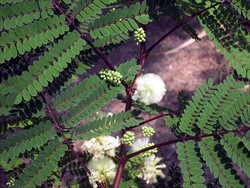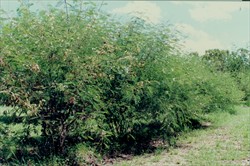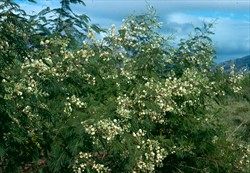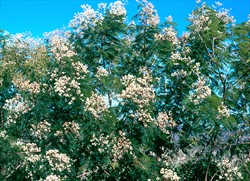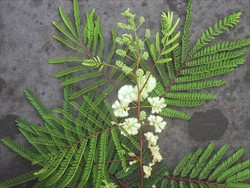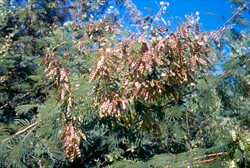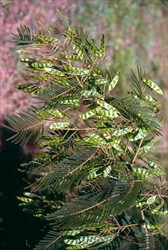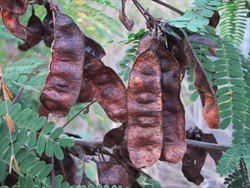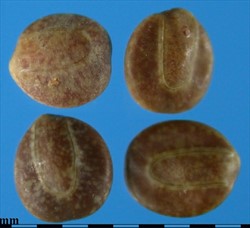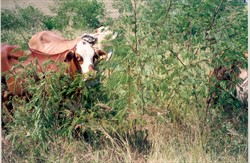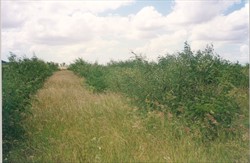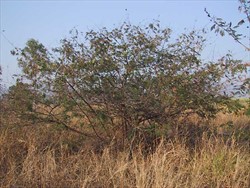Acaciella spp.
Tropical Forages
Three species of Acaciella are used in various parts of the world tropics:
Acaciella angustissima (Mill.) Britton & Rose var. angustissima
Acaciella glauca (L.) L. Rico
Acaciella villosa (Sw.) Britton & Rose
Acaciella angustissima var. angustissima: Basionym: Mimosa angustissima Mill.; Acacia angustissima (Mill.) Kuntze; Acacia angustissima subsp. suffrutescens (Rose) Wiggins; Acacia angustissima var. angustissima (Mill.) Kuntze; Acacia angustissima var. suffrutescens (Rose) Isely; Acacia boliviana Rusby; Acacia suffrutescens Rose; Acaciella suffrutescens (Rose) Britton & Rose; Senegalia angustissima (Mill.) Pedley
Acaciella glauca: Basionym: Mimosa glauca L.; Acacia curassavica (Britton & Killip) Stehlé; Acacia glauca (L.) Moench; Acaciella curassavica Britton & Killip; Leucaena glauca (L.) Benth.
Acaciella villosa: Basionym: Mimosa villosa Sw.; Acacia villosa (Sw.) Willd.
Family: Fabaceae (alt. Leguminosae) subfamily: Caesalpinioideae (mimosoid clade*) tribe: Acacieae.
*Azani, N. et al. [97 authors from 54 institutions] 2017. A new subfamily classification of the Leguminosae based on a taxonomically comprehensive phylogeny. Taxon 66, 44–77.
These three species, being morphologically similar with similar environmental adaptation, are commonly confused with one another and misidentified. Consequently, this sheet deals with them as a group. They are thornless shrubs or small trees, 2–7 (‒12) m high with a single short trunk. Twig pubescence varies from glabrous to short, appressed hairs, on the branchlets. Also variable in size and venation of the leaflets and size of flowers. Leaves bipinnate, predominantly asymmetric with a rachis 10–25 cm long, with 10–20 pairs of pinnae. Inflorescences ellipsoidal with whitish heads 1–1.5 cm in diameter, turning pinkish to dull orange when dry. Pods very thin-walled, papery, oblong, 3–6 cm long and 6–9 mm wide, with straight or sinuate margins, initially green, turning coffee-brown when ripe. Seed production is prolific. 90,000–100,000 seeds/kg.
Species
Acaciella angustissima: A very variable species comprising several varieties. Shrub or tree up to 3 (‒12) m tall, twigs glabrous. Stipules linear, 2–2.5 mm long, persistent. Leaves 10–13.5 (‒21) cm long; petiole 1.2–2 (‒3.5) cm long, upper region channelled, sparsely strigulose; rachis 6.5–8 cm long, sparsely strigulose, glabrous with age, with 11–17 pairs of pinnae, sparsely strigulose; pinnae 2.5–4 (‒5) cm long; paraphyllidia up to 3 mm long; leaflets (pinnules) 20–40 pairs per pinna, 2.4–3.2 × 0.5 mm, linear, base auriculate, apex acute, only the midvein evident on the lower surface, glabrous, shortly ciliate, membranous. Inflorescences consisting of axillary fascicles; peduncles 1–1.3 (‒1.5) cm long, glabrous but sometimes with sparse pearl glands; one inflorescence bract below each raceme, 1 mm long, glabrous, very broadly ovate, caducous, leaving a protuberant scar; floral bract 1.3 mm long, glabrous, clavate, caducous; pedicels 0.6–0.8 mm long, glabrous; flowers white; in short capitulum-like racemes up to 1.5 cm diam. at anthesis. Calyx 0.5–0.8 mm long, 5-lobed (the lobes less than 1/4 the length of the calyx), glabrous. Corolla 4.5 mm long, 5-lobed (the lobes more than half corolla length), glabrous. Stamens 6 mm long. Ovary 1.2 mm long, glabrous, shortly stipitate, the stipe shorter than the ovary, with a basal nectary 0.5 mm high. Legume 4–9 × 1–1.5 × 0.17–0.2 cm, flat, straight, valves chartaceous, conspicuously reticulate, glabrous, acute at the base and apex; stipe 0.7–1.2 cm long; beak 2–5 (‒7) mm long, straight or curved. Seeds 8–12 per fruit, circular in outline, spherical (2.6‒) 2.9–3.2 × 2.5–3 × 1.7–2 mm.
Acaciella glauca: Shrub to 6 m tall, glabrous. Stipules linear, 5 mm long, fugacious. Leaves 10 (‒15) cm long; petiole 2.5‒3.5 cm long, terete, glabrous or sparingly strigose; rachis 4–5 cm long, glabrous or sparingly short strigose, with 2–8 pairs of pinnae; pinnae 4–5 cm long; paraphyllidia <1 mm long; leaflets 6–21 pairs per pinna, 3.5–9 × 3–6 mm, oblong-elliptic, base obtuse, apex rounded to slightly acute, venation reticulate (brochidodromous), visible only on the under surface, glabrous on both surfaces or occasionally shortstrigose below, margins slightly involute on basal half, membranaceous. Inflorescences consisting of clusters of 2–3 capitulum-like racemes on main axis to 12 cm long, glabrous; peduncles 1–1.5 cm long, glabrous, without pearl glands; a single inflorescence bract at the base of each raceme peduncle, linear, 2–2.5 mm, glabrous, fugacious; floral bract 1 mm long, glabrous, clavate, fugacious; pedicels 1 mm long, glabrous; flowers white, yellow when dry, in short racemes, 1.5–2 cm long, when elongated, or 1.5 cm diam. when capitulum-like at anthesis. Calyx 1 mm long, 5-lobed, the lobes less than ¼ of the length of the whole calyx, glabrous. Corolla 2–2.5 mm long, 5-lobed, the lobes to more than half the whole corolla length, glabrous. Stamens 6–7 mm long. Ovary c. 1 mm long, glabrous, short-stipitate; the stipe 0.4 mm long; basal nectary 0.4 mm high. Legume 4.5–8 × 1.2–1.5 × 0.3 cm, flat, straight; valves chartaceous, conspicuously reticulate veined, glabrous, acute at the base and apex; stipe (0.6‒) 1–1.5 cm long; beak 1–2.5 mm long. Seeds 8 per fruit, broadly ellipsoid, 3.5 × 3 × 1.8 mm.
Acaciella villosa: Shrub or tree to 2–5 m tall, glabrous to yellow-hirsute pubescent. Stipules linear, 3.5–5 mm long, fugacious. Leaves 7–16 (‒24) cm long; petiole (1.5‒) 2.5–3 cm long, terete, pubescent; rachis 2.5–5 (‒6) cm long, pubescent, with (3‒) 4–9 pairs of pinnae; pinnae 3.5–5.5 cm long; paraphyllidia 0.3–0.5 mm long; leaflets 9–29 pairs per pinna, (1‒) 2.5–6 (‒10) × 2.5–3 (‒5) mm, oblong, chartaceous, base truncate to truncate-oblique, apex acute to apiculate, main vein subcentral, very inconspicuous reticulate venation visible only on the undersurface, strigose to sericeous pubescent on both surfaces, margins involute. Inflorescences consisting of clusters of (1‒) 2–3 axillary, or sometimes terminal racemes, with an axis, 8–9 (1‒7) cm long, hirsutellous; peduncles (0.7‒) 1.5–2 cm long; strigose, pubescent, without pearl glands; two inflorescence bracts, pubescent, one on the peduncle base, 2 mm long, fugaceous, another inserted about the middle of the peduncle or near to the raceme, 1.5 mm long, fugacious; floral bract 1 mm long, pubescent, clavate, persistent almost until anthesis; pedicels 1.5–2 mm long, glabrous, without pearl glands; flowers white, when dry reddish, in capitulum-like racemes, 1.3–1.5 mm in diam, occasionally the racemes elongate to 2 cm in length at anthesis. Calyx (0.5‒) 0.7 (‒1) mm long, 5- lobed, the lobes less than ¼ the length of the whole calyx, usually glabrous or puberulous. Corolla 2.5–3 mm long, 5-lobed, the lobes to more than half the whole corolla length, pubescent only on the lobes. Stamens 5 mm long. Ovary 1–1.5 mm long, glabrous, short-stipitate, the stipe shorter than the ovary, c. 1 mm long; basal nectary 0.5 mm high. Legume (3.5‒) 4–5 (‒6) × 0.9–1.5 × 0.2 cm, flat, straight; valves chartaceous, densely pubescent, glabrescent, acute at the base and apex; stipe 7.5–13 mm long; legume usually with an apical beak. Seeds 4–8 per fruit, almost spherical, 5 × 3.5 × 2–3 mm.
Note: See "Rico Arce and Bachman (2006)" in "Selected references" for detailed descriptions.
Acaciella angustissima
Latin America: cantebo, cantemo, carboncillo, chilicap, chilipac, guachillo, guaje, guajillo blanco, guajito, guapinico, guapinico, huajillo, ocpatl, palo de pulque, timbe, timbre (Spanish)
English: prairie acacia, prairie wattle, white ball acacia, Bolivian wattle
Acaciella glauca
English: redwood wild dividivi
French: amourette
Acaciella villosa
English: yellow tamarind tree, Jamaican acacia
Acaciella angustissima var. angustissima
Native:
Northern America: Mexico (Aguascalientes, Baja Sur, Campeche, Chiapas, Chihuahua, Coahuila, Colima, Durango, Federal District, Guanajuato, Guerrero, Hidalgo, Jalisco, Michoacán, Morelos, Nayarit, Nuevo Le'on, Oaxaca, Puebla, Querétaro, Quintana Roo, San Luis Potosí, Sinaloa, Sonora, Tabasco, Tamaulipas, Zacatecas, Veracruz, Yucatán; USA (Arizona, Arkansas, Kentucky, Louisiana, New Mexico, Oklahoma, Texas)
Central America: Costa Rica (San José); El Salvador (Ahuachapán); Guatemala (Huehuetenango); Honduras (Choluteca); Nicaragua (Managua); Panama (Bocas del Toro)
South America: Venezuela (Falcón); Argentina (Jujuy, Salta); Bolivia (Beni); Colombia (Antioquia); Ecuador (Loja); Peru (Huanuco)
Cultivated:
Caribbean: Dominican Republic (La Vega)
Acaciella glauca
Native:
Caribbean: Barbados; Guadeloupe; Martinique; Montserrat; Netherlands Antilles (Curacao); St. Vincent and Grenadines (St. Vincent)
South America: Venezuela
Naturalized:
Asia: China; Thailand; Indonesia (Java); Philippines
Australasia: Australia
Indian Ocean: Mauritius
Pacific: Fiji, New Caledonia
Acaciella villosa
Native:
Northern America: Mexico (Chiapas, Chihuahua, Coahuila, Durango, Guerrero, Jalisco, Michoacán, Nayarit, Nuevo León, Oaxaca, Puebla, San Luis Potosí, Sonora, Tamaulipas, Veracruz)
Caribbean: Jamaica
Central America: El Salvador; Guatemala; Honduras; Nicaragua
South America: Colombia; Ecuador; Peru; Venezuela
Naturalized:
Caribbean: Cuba
Forage
While Acaciella spp. are not used extensively as forages, they have been under evaluation throughout the tropics as dry season forages for many years. In Zimbabwe Acaciella spp. have been found to have limited value as “dry season forage” because of the high level of leaf drop (complete by end of the dry season), so are utilized in the wet season or conserved as leaf meal.
Environment
Acaciella spp. have found application in agroforestry, and are being tested as a fallow species to restore soil fertility in dryland cropping systems. Their benefits to crops as green manure are only realized in the second crop following application because leaf protein is bound in complexes with condensed tannins, resulting in the slow release of N for crop growth.
Other
Wood can be used for fuel, flowers for bee forage, and the bark in the fermentation of traditional Mexican alcoholic drinks. It has also been reported as a medicinal plant in Mexico.
Soil requirements
Grow mostly on free-draining acid soils in their native range. Adapted to a wide range of soils including vertisols of slightly alkaline pH. A. angustissima is known to be tolerant of at least moderate salinity.
Moisture
In the native range, annual rainfall varies from 800 to 3,000 mm. They can withstand moderate periods of drought, retaining leaf through 8-month dry season in eastern Indonesia, although high level of leaf drop have been reported in Zimbabwe. Leaf drop differences may be attributable to differences in species and accession as well as environment.
Temperature
They grow naturally from near sea level to 2,800 m in environments where mean temperatures range from 25 to 30 °C. Show better growth potential at higher elevations and moderate temperatures. Tolerate cold climates once established (occasional temperatures below freezing).
Light
Unknown. May have moderate shade tolerance being native to oak/pine forests.
Reproductive development
Flower throughout the year in thei rnatural range, and at the end of the dry season in trials in Zimbabwe.
Defoliation
Highly tolerant of repeated defoliation.
Fire
Tolerant of annual burning of rangelands once mature.
Guidelines for establishment and management of sown forages.
Establishment
Can be direct seeded or grown from transplanted seedlings. Spacings vary with purpose and farming system. For hedgerows in cropping systems or open forages, plant at 0.5 m spacings into rows 3–8 m apart. Fodder banks have been planted at 1 × 2 m and 2 × 2 m spacings, for example. When direct seeding, sow seed on the surface of cultivated soil and cover with a layer of soil equal to the width of the seed. Weed control is essential for successful establishment. Under favourable conditions, some Acaciella accessions have grown to a height of 5 m and 6 cm in diameter in 2½ years.
Scarification can improve germination. Seed pre-treatment of 12 hours soaking in cool water prior to sowing has also improved germination. In other trials hot water treatment for 10–15 secs at 80–90 ºC resulted in 97–100% germination, whereas >20 secs or hotter water (straight off the boil) decreased germination percentage.
Fertilizer
Responds well to fertilizer when grown on acid-infertile soils. Fertilizer application resulted in a 7-fold increase in crown volume of trees grown on acid soils in Hawaii. Nodulation has also been significantly improved with K and P fertilization.
Compatibility (with other species)
Compatible with a wide range of native and exotic pasture grasses. Limited palatability may result in excessive growth of Acaciella spp. and shading of understorey species.
Companion species
In an alley cropping system intercropped with sweet potato (Ipomoea batatas) in Papua New Guinea, A. angustissima provided enough N, P and K for the crop, but inhibited the tuber yield due to the rapid tree growth, which shaded the crop.
Pests and diseases
In its native habitat, A. angustissima is eaten by the larvae of the acacia skipper butterfly, Cogia hippalus, and by the larva of moth Sphingicampa blanchardi and S. raspa.
Resistant to attack by the Chinese rose beetle (Adoretus sinicus) in Hawaii.
Ability to spread
Will spread under grazing if not regularly controlled. (See "Weed potential").
Weed potential
The ability to tolerate repeated coppicing, in combination with its prolific seed production, rapid growth and low palatability to ruminant livestock, has enabled Acaciella spp. to become weeds in their native range and in exotic locations, forming thickets along roadsides and on free-draining soils in rangelands. Extreme caution should be exercised in introducing Acaciella spp. to exotic environments.
Nutritive value
In sacco digestibility of only 48% (after 48 hours), moderate condensed tannin concentrations (6–11%) and low palatability render A. angustissima a low quality forage. Despite this, it is an important dry season feed in some seasonally dry environments. Nutritive quality is higher for ruminants adapted to A. angustissima, as adapted rumen flora degrade toxic compounds; however moderate concentrations of highly astringent condensed tannins limit intake and digestibility.
In Ethiopia, indicators of reasonable nutritive quality (in vitro gas production, in situ DM degradation and IVDMD) were reported when A. angustissima was fed as a mixed supplement with Sesbania sesban.
Palatability/acceptability
Due to the fact that these species are commonly misidentified it is not possible to draw conclusions on relative palatability. However most agree that they have very low to moderate palatability. There are no reports of their being readily consumed by livestock.
Toxicity
Contain approximately 6–11% of anti-nutritive condensed tannins; also toxic compounds such as low molecular weight phenolic compounds and non-protein amino acids.
Dry matter
Highly productive in favourable, seasonally dry environments, producing 10–12 t/ha/year DM. On acid-infertile soils in high rainfall environments in northern Australia and Indonesia, up to 13 t/ha/year were produced in unfertilized small plots. In less favourable environments production was over 2 t/ha/year. Although not universally true, ability to retain leaf throughout long dry seasons is particularly important (see comment in Uses/applications). At 2 sites in Zimbabwe, annual forage yields increased from approximately 1.0 t/ha in the planting year to 3.5 and 5.0 t/ha in the second and third years following establishment.
Animal production
Animals should be introduced gradually to Acaciella spp. to allow rumen flora to adapt to presence of toxins that have caused death in sheep with sudden exposure to sun-dried material. High levels of tannin in the leaf would have a detrimental effect on animal performance.
2n = 2x = 26. No breeding programs are being undertaken. A large number of accessions/provenances from across the native range are held by ILRI.
These are generally prolific seed producers. However, at lowland sites (20 m asl) in Papua New Guinea, Acaciella flowered but did not seed, while at higher elevation (1,650 m) it seeded prolifically.
Can be controlled using basal bark or cut-stump applications of tree-killing herbicides such as fluroxypyr, triclopyr or trichlopyr + picloram. Seedlings can be controlled using complete foliar sprays of fluroxypyr.
- High dry matter production in harsh environments.
- Tolerant of acid-infertile soils.
- Tolerant of regular coppicing.
- High N fixation and CP content.
- Contain moderate quantities of condensed tannins, non-protein amino acids and other anti-nutritive and toxic compounds.
- Poor liveweight gains in ruminants.
- Slow nutrient release from green manure.
Biosecurity Queensland (2016) Invasive plant risk assessment – Redwood Acaciella glauca (syn. Acacia curassavica, Acacia glauca). Department of Agriculture and Fisheries, Brisbane, Australia. bit.ly/2W6H87d
Biosecurity Queensland (2016) Invasive plant risk assessment – White ball acacia Acaciella angustissima (syn. Acacia angustissima, Acacia boliviana). Department of Agriculture and Fisheries, Brisbane, Australia. bit.ly/33k59ta
Bray, R.A., Palmer, B. and Ibrahim, T.M. (1997) Performance of shrub legumes at four sites in Indonesia and Australia. Tropical Grasslands 31:31–39. bit.ly/2Qa9rOt
Gutteridge, R.C. (1994) Other species of multipurpose forages tree legumes. In: Gutteridge, R.C. and Shelton, H.M. (eds) Forage Tree Legumes in Tropical Agriculture. CAB International, Wallingford, Oxon, UK. p. 97–108. bit.ly/38LYfxV
Odenyo, A.A., Osuji, P.O., Reed, J.D., Smith, A.H., Mackie, R.I., McSweeney, C.S. and Hanson, J. (2003) Acacia angustissima: Its anti-nutrients constituents, toxicity and possible mechanisms to alleviate the toxicity- a short review. Agroforestry Systems 54(3):141–147. doi.org/10.1023/A:1026360912944
Preece, D. and Brook, R. (2001) Acacia angustissima - A promising species for agroforestry. Winrock International, Morrilton, AR, USA. bit.ly/2TYwYml
Rico Arce, M. de L. and Bachman, S. (2006) A taxonomic revision of Acaciella (Leguminosae, Mimosoideae). Anales del Jardín Botánico de Madrid 63(2):189–244. doi.org/10.3989/ajbm.2006.v63.i2.7
None released.
CPI 40175 Origin La Plasuela, La Paz, Bolivia, (16°28' S, 67°22' W). Moderate palatability to grazing cattle in research trials in tropical Australia. Research not continued due to perceived weed risk. Under nutritional evaluation in Zimbabwe.
CPI 84998 Origin Cabo San Lucas, Baja California Sur, Mexico (22°55' N, 100 m asl, rainfall 240 mm). Along with CPI 40175, highest yielding of 21 accessions from 8 genera evaluated for agronomic performance on acid-infertile soils in humid tropical environments in northern Australia and Sumatra, Indonesia.
ILRI 15132 (A. angustissima ) Origin Salitrales, Puriscal, Costa Rica (9°5' N, 1,100 m asl, rainfall 2,500 mm). Best of the ILRI accessions in terms of yield and agronomic adaptation. Used experimentally as a forage supplement.
ILRI 469 (A. angustissima ) Origin Corozal, Belize, (18°1' N, 7 m asl, rainfall 1,455 mm). Excellent forage production in Zimbabwe.
